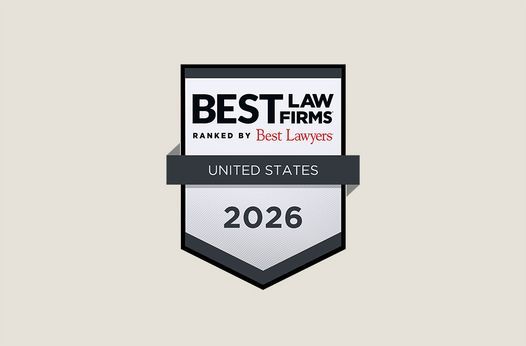Capital Simplification for Community Banking Organizations
Hinshaw Alert | 4 min read
Oct 29, 2019
On September 17, 2019, the federal bank regulatory agencies (the "Agencies") adopted a new rule to provide for a simplified measure of capital adequacy for certain community banking organizations. The rule takes effect on January 1, 2020.
Under the rule, most insured depository institutions and depository institution holding companies with less than $10 billion in total consolidated assets that meet certain qualifying criteria (a "QCBO") and that have a community bank leverage ratio ("CBLR") greater than 9 percent would be eligible to use the CBLR framework. If it chooses to do so, a QCBO will only report the CBLR ratio on its Call Report or FR Y-9C. It will not have to report the traditional risk-based capital ratios contained in the Agencies existing capital rules.
A. Qualifying Community Banking Organization
A QCBO is defined as an insured depository institution or depository institution holding company that is not an advanced approaches banking organization and that meets the following criteria ("qualifying criteria"):
- a leverage ratio of 9 percent or greater;
- average total consolidated assets of less than $10 billion;
- total off-balance sheet exposures (excluding derivatives that are not credit derivatives and unconditionally cancelable commitments) of 25% or less of total consolidated assets; and
- total trading assets and trading liabilities of 5% or less of total consolidated assets.
B. Calculation of the CBLR
The CBLR is calculated by dividing the QCBO's Tier 1 capital by its average total consolidated assets.
Average total consolidated assets would be calculated in accordance with Call Report or FR Y-9C instructions.
A QCBO with a CBLR greater than 9 percent would be considered to have met:
- the generally applicable capital requirements;
- the well capitalized capital ratio requirements under the Agencies' Prompt Corrective Action framework ("PCA") in the case of an insured depository institution; and
- any other capital or leverage requirements to which the banking organization is subject.
Additionally, to be considered well capitalized under the CBLR framework a QCBO must not be subject to any written agreement, order, capital directive, or PCA directive.
C. Election of CBLR Framework; Opt Out of Framework
A QCBO may elect to use the CBLR framework if its CBLR is greater than 9 percent and may start doing so in its Call Report on Form FR Y-9C for the first quarter of 2020 or any quarter thereafter.
A QCBO may opt out of the CBLR framework in any subsequent quarter by completing its Call Report or FR Y-9C reporting the capital ratios required under the traditional capital rules.
In theory, there are no restrictions on the ability of a QCBO to opt out of the CBLR framework. However, the Agencies have indicated that a QCBO electing to opt out of the CBLR framework should be able to provide a rationale for opting out of the framework if requested by the appropriate Agency.
A QCBO that has opted out of the CBLR framework and desires to opt back in would need to meet the qualifying criteria discussed above, including a CBLR of greater than 9%.
A QCBO does not have to use the CBLR framework.
D. Treatment of QCBOs That Cease to Qualify for the CBLR Framework
A QCBO that no longer meets the qualifying criteria would be required, within a limited grace period, to meet either the qualifying criteria or comply with the generally applicable capital requirements. The grace period would begin as of the end of the calendar quarter in which the QCBO ceases to meet the qualifying criteria and end after two consecutive calendar quarters.
In order to take advantage of this grace period, the QCBO must maintain a CBLR of 8% or greater. If the QCBO fails to maintain an 8% ratio during the grace period or fails to increase its CBLR to 9% by the end of the grace period, it will have to comply with the traditional risk-based capital rules when preparing its next Call Report or FR Y-9C.
During this grace period, a QCBO may continue to be treated as a qualifying community banking organization and is presumed to satisfy the "well capitalized" ratio requirements and be in compliance with the generally applicable rule without having to calculate and report risk-based capital ratios.
E. Impact on Bank Holding Companies
The Agencies have reported that as of March 31, 2019, there are 4,261 depository institution holding companies with less than $10 billion in total consolidated assets. More than 95 percent of such holding companies are not subject to the traditional capital rules because they have less than $3 billion in total consolidated assets and meet certain additional criteria to qualify for the Fed's Small Bank Holding Company and Savings and Loan Holding Company Policy Statement.
As a consequence, it may not make sense for such bank holding companies to elect to participate in the CBLR framework. Their subsidiary banks, however, are subject to the traditional capital rules and should consider making the election.
For a discussion of the small bank holding company and savings and loan holding company policy statement, see our Hinshaw client alert.
For further information of the CBLR framework, please contact Tim Sullivan (312-704-3852 | tsullivan@hinshawlaw.com) or Michael Morehead (217-467-4915 | mmorehead@hinshawlaw.com), or your regular Hinshaw attorney.
Tax advice disclosure: To ensure compliance with the Internal Revenue Service Regulations governing the issuance of advice on Federal Tax issues, we advise you that any tax advice in this communication (and any attachments) is not written with the intent that it be used, and cannot be used, to avoid penalties that may be imposed under the Internal Revenue Code.
Related People
Related Capabilities
Featured Insights

Press Release
Jan 6, 2026
Hinshaw Adds Four-Member Consumer Financial Services Team in DC and Florida

Employment Law Observer
Dec 8, 2025
12 Days of California Labor and Employment: 2025 Year in Review

Press Release
Dec 4, 2025
Hinshaw Recognized by the Leadership Council for Legal Diversity as a 2025 Top Performer

Press Release
Nov 25, 2025
Hinshaw Legal Team Secures Summary Judgment in Gas Station Injury Case

Press Release
Nov 18, 2025
Hinshaw Releases the Third Edition of Duty to Defend: A Fifty-State Survey

In The News
Nov 13, 2025
A Profile on Neil Rollnick: After 57 Years in Practice, He Has No Plans to Retire








